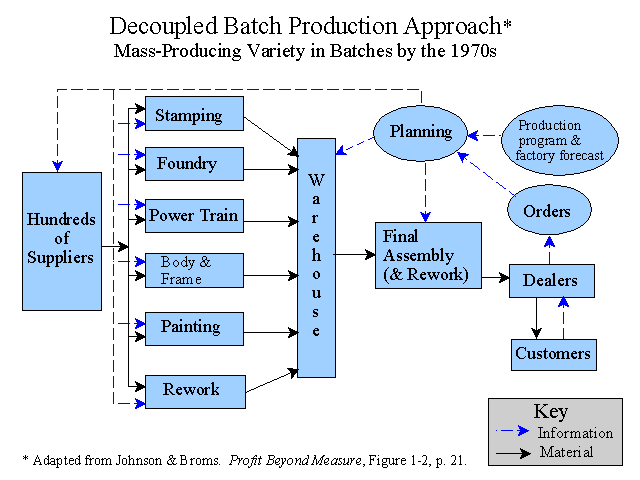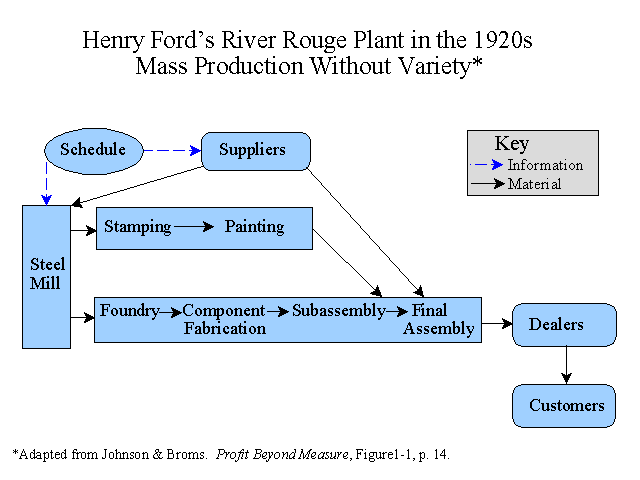
Chapter 6
Management Accounting Information for Activity and Process Decisions
Study Guide by James R. Martin, Ph.D., CMA
Professor Emeritus, University of South Florida
ABKY Main Page |
Martin's Textbook Main Page
The main topics covered in this chapter include some terminology related to the relevant costs concept, some examples of relevant cost decisions, the various types of facility layouts, the quality cost conformance model and just-in-time manufacturing.
2. Relevant Costs and Sunk Costs
Relevant costs, also referred to as differential costs, are costs that will be different when one alternative is selected over competing alternatives. Sunk costs are costs that are irrevocable, or unavoidable. Sunk costs are not relevant to a decision although, as ABKY point out in the text, it is difficult for managers and people in general to ignore sunk costs. Their example on pages 220-221 illustrates the concepts of relevant and sunk costs. The amount paid down on a recently acquired machine ($30,000 sunk costs) is not relevant to the decision to replace the machine.
3. Types of Relevant Cost Decisions
There are a substantial number of relevant cost decisions such as:
1. Replacement of an old piece of equipment.
2. Make or buy or outsourcing product components or services.
3. Changing the facility layout.
4. Determining the optimum level of conformance quality.
The four relevant cost decision models above are discussed in this chapter. A
few other models include:
5. The economic order quantity (EOQ) model.
6. The economic batch size model.
7. Special order pricing.
8. Determining the optimum product mix.
9. Determining whether to process joint products beyond the split-off point.
An example of a make or buy decision is provided on pages 222-224. The question is whether to outsource the rear lamp C57D. All of the production costs are relevant except the facility sustaining costs that have been charged to the C57D. The cost analysis shows that the company would be better off to outsource by $6 per unit. However, the qualitative factors such as supplier reliability, quality, on time delivery, etc. also need to be considered.
ABKY discuss four types of facility layouts.
1. Process layouts. Similar equipment is grouped together by function in production departments. Each department tends to work at its on pace creating high work in process inventory levels. The graphic below, adapted from an illustration in Profit Beyond Measure conveys the concept. (Summary).

2. Product layouts. The layout is designed for specific products such as an assembly line. Another graphic adapted from Johnson and Broms illustrates this concept.

3. Cellular layouts. The various types of equipment needed to produce a product are located close together frequently in a U-shaped arrangement. See ABKY Exhibit 6-5.
The purpose of the cellular layout is to reduce waste and improve cycle time . Materials related costs are reduced such as materials handling and storage. Cycle time includes the time from the receipt of raw materials to the time the product is delivered to the customer. Cycle time efficiency is measured by the ratio of processing time to the total cycle time. This measurement places emphasis on reducing moving time, storage time and inspection time.
The theory of constraints is mentioned on page 225 and briefly discussed in the illustration on page 228. The goal in TOC is to make money, now and in the future. Three global measurements are used including:
Throughput - Sales less direct materials in the products sold.
Inventory
- Investment or total assets. Not the usual concept of inventory.
This term is incorrectly defined on page 225 and on slide 6-44.
Operating expense - All costs except direct materials are expensed.
There is not enough information on TOC in this chapter to get a grasp of the concepts.
See MAAW's TOC topic for more information.
6. The Quality Cost Conformance Model
As ABKY explain on page 239, the quality cost conformance model includes four types of costs including:
Prevention costs - costs incurred because poor quality can exist. Examples include quality engineering, training, statistical process control.
Appraisal costs - costs also incurred because poor quality can exist. Examples include inspection and quality audits.
Internal failure costs - costs incurred because poor quality does exist. Examples include defects or spoilage, scrap and rework.
External failure costs - costs also incurred because poor quality does exist. Examples include warranty claims, service calls and repairs, product returns, product recalls and lawsuits. Lost sales is also a very important external failure cost, but not measurable.
In the quality cost conformance model, the economic conformance level (ECL) is obtained where prevention and appraisal costs are equal to external and internal failure costs as indicated in the graphic illustration below.

Prevention and appraisal costs increase as the level of conformance quality increases. Conformance quality refers to conformance to specifications as opposed to design quality, i.e., service functions or features. Failure costs are expected to decrease as the level of conformance quality increases. Therefore, the total costs associated with conformance quality will be U-shaped as indicated in the exhibit above.
The quality cost conformance model is controversial. See the quality cost model and the Gabel summary for more information.
Just-in-time manufacturing is a demand pull approach where products or services are produced when authorized from a down stream customer. Of course there are internal customers as well as external customers. Although ABKY concentrate on JIT manufacturing in this chapter, JIT is applicable to the entire value chain. JIT systems include many concepts and techniques. For example, the cellular layout discussed above is an important part of a JIT manufacturing system. An essential ingredient is cooperation and teamwork across the company.
Some potential benefits obtained from JIT manufacturing include reductions in inventory levels, internal failure costs such as defects, scrap and rework, carrying costs, handling costs, and cycle time.
See MAAW's JIT topic of more information.
1. Why should decision makers focus only on the relevant costs for decision making?
2. Are sunk costs relevant? Explain. (See item 2 above).
3. What behavioral factors may influence some managers to consider sunk costs as being relevant in their decisions?
4. Are direct materials and direct labor costs always relevant? Explain with examples. (See items 2 and 3 above).
5. When are (1) product-sustaining and (2) facility sustaining (business sustaining) costs relevant? Give examples of each. (See items 2 and 3 above).
6. Why can't we compare cash flows at different points in time? (See Note on the IRR and NPV).
7. Are avoidable costs relevant? Explain. (See item 2 above).
8. Give two examples of costs and decision contexts in which the costs are not relevant for a short term context but are relevant for a long term context.
9. Why are facility-sustaining (business sustaining) support costs often not relevant for make-or-buy decisions? Give an example when facility sustaining support costs are relevant for a make-or-buy decision.
10. What qualitative considerations are relevant in a make-or-buy decision? (See item 3 above).
11. What are the opportunity costs that are relevant in a make-or-buy decision?
12. The theory of constraints relies on three measures: throughput contribution, investments, and operating costs. Define these three measurements in the context of the theory of constraints. (See item 5 above).
13. What is the difference between process and product layout systems? (See item 4 above).
14. What is cellular manufacturing? (See item 4 above).
15. How is a just-in-time manufacturing system different from a conventional manufacturing system? (See item 7 above for a short answer and MAAW's Chapter 8 for a long answer).
16. What creates the need to maintain work-in-process inventory? Why is work-in-process inventory likely to decrease on the implementation of cellular manufacturing, just-in-time production, and quality improvement programs? (See item 7 above for some ideas).
17. Why are production cycle time and the level of work-in-process inventory positively related?
18. List two types of costs incurred when implementing a cellular manufacturing layout.
19. What are two types of financial benefits resulting from a shift to cellular manufacturing, just-in-time production, or continuous quality improvements? (See item 7 above).
20. What is meant by the term cost of nonconformance? (See item 6 above).
21. Waste, rework, and net cost of scrap are examples of what kinds of quality costs? (See item 6 above).
22. Quality engineering, quality training, statistical process control, and supplier certification are what kinds of quality costs? (See item 6 above).
23. List three examples for each of the following quality costing categories:
a. prevention costs
b. appraisal costs
c. internal failure costs
d. external failure costs
(See item 6 above).
24. What is the additional cost of replacing one unit of product rejected at inspection and scrapped?
25. What is the additional cost if a unit rejected at inspection can be reworked to meet quality standards by performing some additional operations?
26. What costs and revenues are relevant in evaluating the profit impact of an increase in sales?
27. "Design an accounting system that routinely reports only relevant costs," advised a management consultant. Is this good advice? Explain. (See the summaries for Chapter 3 and Chapter 1, item 5).